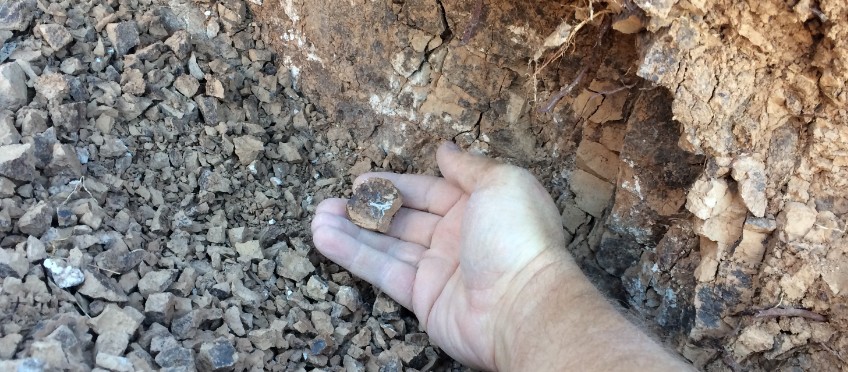Discovering and utilizing natural resources for pottery is a rewarding journey, especially when it involves the readily available river clay in Georgia. Many aspiring and experienced potters are unaware of the abundance of wild clay and how simple it is to process it for ceramic creations. This guide will walk you through identifying, collecting, and preparing fresh river clay in Georgia, empowering you to connect with the earth’s materials and elevate your pottery practice.
Identifying River Clay in Georgia
River clay, like all clay, possesses distinct visual and tactile characteristics that make it identifiable in its natural environment. When exploring the riverbanks and waterways of Georgia, keep an eye out for these key indicators:
Crackled Texture When Dry
One of the most telling signs of clay is its crackled surface when dry. Imagine the parched earth at the edge of a dried riverbed – this network of cracks is a strong indication of clay deposits beneath. Clay minerals expand when wet and contract as they lose moisture, leading to this characteristic cracking. Observing this texture in Georgia’s riverbeds is often the first step in locating potential clay sources.
Hard, Angular Chunks When Dry
River clay, when dry and undisturbed, often forms into hard, angular chunks. These pieces are not as solid as rocks but possess a notable hardness and a distinctive smooth, sometimes waxy or soapy feel. Examine exposed riverbanks or areas where erosion has occurred; you may notice these angular clay fragments. They can sometimes exhibit a darker surface patina, a result of minerals deposited over time through repeated wetting and drying cycles, common in Georgia’s river environments.
Soft, Plastic Texture When Wet
The most recognizable characteristic of clay emerges when it’s wet. River clay, when moistened, displays the soft, pliable, and plastic consistency that is synonymous with pottery clay. When exploring damp areas near rivers in Georgia, be alert for slick, sticky patches underfoot. These are likely areas rich in river clay. On drier ground that has recently been wet, look for deep impressions from tires or footprints, signs of vehicles or people traversing clay-rich soil.
Field Testing Your River Clay Find
Once you’ve located a substance that you suspect might be river clay, a simple field test will help confirm your discovery. The key is to assess its plasticity.
To test the plasticity of your potential Georgia river clay, moisten a sample if it’s dry. Often, river clay found near the water’s edge will already possess some moisture. If your sample is dry, simply pour a little water onto it in your hand and begin to knead it. You might need to repeat the wetting and kneading process a few times to achieve the right moisture level, as different clays vary in their absorption rates.
Once the clay is thoroughly wet, attempt to roll a small coil between your palms. Then, carefully try to bend this coil around your finger. If the coil cracks and breaks easily, the clay may lack sufficient plasticity. However, if the coil bends smoothly around your finger without significant cracking, it indicates good plasticity – a promising sign that you’ve found usable river clay.
River clay with good plasticity is an excellent candidate for further processing and pottery making. Collect a generous amount for yourself and consider taking a little extra to share with fellow pottery enthusiasts!
Processing Your Fresh Georgia River Clay
After successfully identifying and collecting river clay from a Georgia waterway, the next step is to process it into a workable material for pottery. Testing the clay by creating something is the ultimate way to determine its suitability for your intended ceramic projects. Dry processing is an efficient method to quickly prepare your river clay for use.
Dry Processing Method for River Clay
Begin by ensuring your river clay is completely dry. If it’s damp from collection, spread it out in a dry location, protected from rain, for several days to air dry. Alternatively, you can expedite the drying process by placing the clay on a baking sheet and setting it in a low-temperature oven for a couple of hours to remove all moisture. Rest assured, the oven’s heat will not be sufficient to fire the clay into ceramic.
Once the river clay is thoroughly dry, it needs to be broken down into smaller particles. A straightforward method is to place the dried clay on a concrete surface like a patio or driveway and pound it with a hammer or a sturdy rock. The goal is to reduce the clay to a consistency similar to coarse sand; it doesn’t need to be pulverized into a fine powder.
After grinding the river clay, the next crucial step is to add sand. Mix approximately 20% sand into the ground clay and blend thoroughly. Why add sand? Sand acts as a crucial tempering agent, increasing the clay’s porosity. This enhanced porosity facilitates better moisture evaporation during the drying process, which is vital for preventing cracks in your pottery pieces as they dry. A 20% sand addition can be achieved using a ratio of four parts ground river clay to one part sand. Mix these components thoroughly. While 20% is a good starting point, the ideal clay-to-sand ratio can vary depending on the specific properties of your river clay, so experimentation is encouraged to find the optimal mix for your clay.
Now, you are ready to rehydrate your clay mixture. Gradually add water to the clay and sand mixture, kneading it continuously to ensure even distribution of moisture. Continue adding water, a little at a time, and kneading until the clay reaches a desirable plastic consistency. Achieving the perfect consistency requires practice and familiarity with clay. Too much water will result in overly sticky, gloopy clay, while too little water will leave the clay stiff, prone to cracking, and difficult to work with.
Next Steps with Your River Clay Pottery
Your Georgia river clay is now processed and ready to be shaped into pottery! While firing is the subsequent step to transform your clay creations into durable ceramics, it is beyond the scope of this guide.
Should you wish to explore primitive firing techniques, resources are available online and in pottery communities within Georgia. If you plan to fire your river clay pottery in an electric kiln, caution is advised. The firing temperature tolerance of wild clays is unknown until tested. It’s essential to conduct test firings at incrementally increasing temperatures to determine the clay’s safe firing range before it begins to melt or deform. Always place your test piece (and subsequent river clay pottery during initial firings) in a bowl or on a previously fired tile to contain any potential melting and prevent damage to your kiln shelf.
Expanding Your Knowledge of Wild Clay
This guide provides a foundational understanding of working with fresh river clay in Georgia. However, the world of wild clay is vast and offers endless opportunities for learning and discovery. Consider exploring video-based online classes dedicated to wild clay for more in-depth knowledge and visual demonstrations of clay identification, processing, and utilization. You can also find valuable resources and communities through local pottery guilds and workshops in Georgia, where experienced potters often share their expertise in working with native clays. Embrace the journey of learning and experimenting with the natural clay resources of Georgia, and unlock a deeper connection to the art of pottery.


